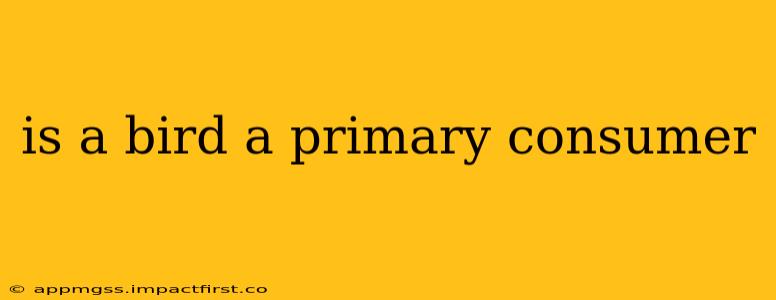Birds occupy a diverse array of ecological niches, and their role in the food chain isn't always straightforward. While many birds are primary consumers, many are not. Let's delve into the specifics to understand why.
What is a Primary Consumer?
Before we classify birds, let's define the term. A primary consumer is an organism that feeds on producers – primarily plants – in a food chain or food web. Producers are autotrophs, meaning they create their own food through photosynthesis (like plants, algae, and some bacteria). Therefore, primary consumers are herbivores.
Are All Birds Primary Consumers?
No, not all birds are primary consumers. This is because birds exhibit an incredibly wide range of dietary habits. Their classification depends entirely on their primary food source.
Birds as Primary Consumers (Herbivores)
Many bird species are indeed primary consumers. These birds primarily eat plants, seeds, fruits, and nectar. Examples include:
- Finches: Many finch species rely heavily on seeds.
- Parrots: Many parrot species consume fruits, nuts, and seeds.
- Hummingbirds: These tiny birds are nectarivores, surviving primarily on the nectar of flowers.
- Seed-eating waterfowl: Species like ducks and geese often consume significant amounts of aquatic plants and seeds.
Birds as Secondary Consumers (Carnivores and Omnivores)
A large number of bird species are secondary consumers, meaning they eat primary consumers (herbivores) or other animals. These birds are either carnivores (meat-eaters) or omnivores (eating both plants and animals). Examples include:
- Birds of prey (raptors): Eagles, hawks, owls, and falcons are apex predators, feeding on smaller birds, mammals, reptiles, and amphibians.
- Shorebirds: Many shorebirds, like sandpipers and plovers, feed on invertebrates like insects and crustaceans, which are primary or secondary consumers themselves.
- Kingfishers: These birds specialize in catching fish, which are also consumers.
- Crows and ravens: These highly intelligent birds are omnivores with diverse diets including seeds, fruits, insects, carrion, and small animals.
Birds as Tertiary Consumers
Some birds even occupy the role of tertiary consumers, feeding on other secondary consumers. This is less common but still occurs within certain food webs.
What About Insectivorous Birds?
Insectivorous birds, which eat insects, present a slightly more complex classification. Insects themselves can be primary, secondary, or even tertiary consumers, depending on their diet. Therefore, an insectivorous bird's position in the food chain depends on the dietary habits of the insects it consumes. If the insects primarily eat plants, the insectivorous bird would be considered a secondary consumer.
In Summary: It Depends on the Bird's Diet
To determine if a bird is a primary consumer, one needs to carefully examine its diet. A bird's classification as a primary, secondary, or tertiary consumer is based solely on its primary food source within the specific ecosystem it inhabits. The diversity of bird diets highlights the intricate and interconnected nature of food webs.
